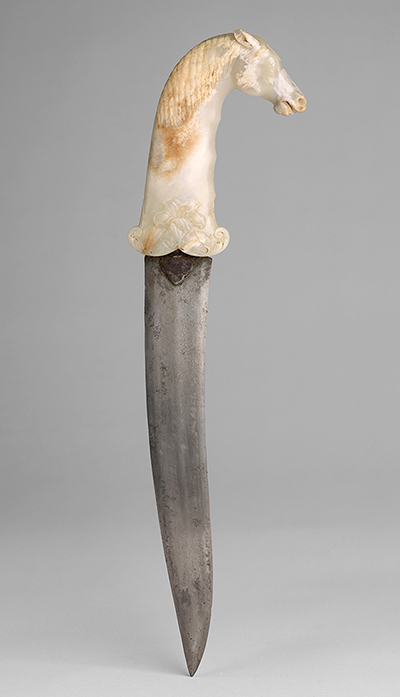Mughal, India, 1640-50
Nephrite jade and steel
40.5 x 11 x 2.5 cm; Hilt Height: 13.5 cm
The dagger hilt conveys the artisan’s mastery in craftsmanship as well as his keen understanding of the natural world, artistic traits that have come to define the decorative arts produced under the Mughals during the seventeenth century. Its virtuosity in execution strongly suggests that it was created by a master lapidarist in the imperial Mughal workshop, under the reign of Shah Jahan (r. 1628-1658). Like his father, Jahangir (r. 1605-1627), Shah Jahan was a great patron of the lapidary arts, and works that captured the details of the natural world with awe-inspiring realism. He demanded meticulous attention to detail and stylistic accuracy, which are not only demonstrated here, but also through other notable jade works produced under his rule, such as the famous gourd-shaped wine cup, also made of white nephrite, that is currently housed in the Victoria and Albert Museum in London.
Horses played a vital role in Mughal society. Their warfare practices, derived from their Central Asian ancestors, greatly relied on them; armies were primarily comprised of mounted archers and heavy calvary. The emperor Akbar (r. 1556-1605), even installed an administrative system for ranking nobles and officers called mansbadar, that was partly determined by the number of cavalry and horses one had under him. Due to their importance, horses were treated with the utmost care. At imperial stables, horses were given rich diets and had a team of attendants for their care and maintenance, which included the esteemed position of the atbegi, the master of the horse.
Rachel Parekh
This exquisite 17th century jade-hilted dagger, or khanjar, from the Mughal empire is a masterpiece of the lapidary arts and rendered in the most extraordinary detail in the form of a horse’s head. The pommel, beautifully rendered in equine form, is carved from a light coloured nephrite-jade known as mutton-fat nephrite and its translucence is marked by pale yellow and white inclusions, which the artist used to represent the mottled variations in the coat of the animal and elevates the naturalism within the form.
The horse’s head is an artistic tour de force that likely portrays an Arabian stallion, which was generally regarded as the superior breed by the Mughals and, therefore, befitting the supreme status of its powerful owner. Functioning as the hilt of the dagger, the elongated neck of the horse descends in graceful curvature; at the front, a series of three sequential bowing lines create the finger rests. Below, the quillon block is intricately carved with upward sweeping leaves that terminate in curls on either side, with an arrangement of acanthus leaves and a lotus head sprouting from the centre. The steel blade has a slight re-curve and is ridged and double-edged.
The details of the horse’s face are wonderfully captured with ears facing back, nostrils flared and mouth slightly open as if ready for battle. The eyes are delicately and expressively rendered; between and just above them a short forelock hangs centrally down the faceted bridge of the nose while the delicately incised mane falls gracefully down one side of the neck. Here the artisan has excelled in his use of carved jade as dark inclusions in the stone appear along the horse’s neck and emphasising the refined details of the mane.
Even the smallest details are treated with the utmost sensitivity whilst the expressive features of the face invite comparison with the great contemporary animal artist Mansur whose vivid portraits of animals and birds earned him the sobriquet Nadir al-Asr, “Wonder of the Age.”
The nephrite jade would have enhanced the appearance of the dagger, while the weight of the hilt would also have helped to counterbalance the steel blade. Although nephrite is a hard and durable material, one major disadvantage is that it could be liable to damage from sharp impacts, possibly sufficient to render the dagger unusable without a replacement hilt. Considering the materials used and also the quality of the workmanship, this would have been made for a wealthy or powerful person.

Daggers with jade animal hilts were reserved for individuals of the highest rank and status at the Mughal court. The present example pays eloquent tribute to a culture that gave primacy to technical excellence and empirical observation. Expressive in its subject-matter and refined in its execution, this sculptural tour de force captures the essence of royal taste and high fashion in 17th century India. Cary Welch’s close study of courtly figures in the Windsor Castle Padshahnama reveals that the small number of daggers with animal hilts were reserved for the use of princes and senior dignitaries (1). In the miniature Shah Jahan receiving an embassy of Europeans (2), the emperor’s sons, Dara Shikoh and Shah Shuja, are seen wearing daggers with nilgai hilts (Ibid., p.56-7).
The use of jade however only became evident during the Mughal period, reaching its artistic zenith during the 17th century under the patronage of the Mughal emperors Jahangir (r.1605-27) and Shah Jahan (r.1628-57). Amongst the most personal objects in the possession of a Mughal prince or courtier was his “parade” or “dress” dagger. By Jahangir’s reign, edged weapons were no longer used exclusively for warfare: they had become great works of art in their own right, being decorated with enamels, precious metals, and stones.
A close comparable piece from the Shah Jahan period likely made for his inner circle is in the Al Sabah collection, Kuwait, and a Dagger with Hilt in the Form of a Blue Bull, formerly in the Heeramaneck collection, is in the collection of The Metropolitan Museum of Art, Acc. No: 1985.58a, b.
Provenance:
Anthony Biggs, UK, 1969-70.
Bashir Mohamed, UK, 1970-1992.
Spink and Son, London, 1992.
Simon Ray, London, 2002-4.
Private collection, London, 2004-2023.

If you would like to stay up to date with exhibitions and everything else here at Prahlad Bubbar, enter your email below to join our mailing list